How Much Tippet for Tenkara?
How do you decide on the perfect tenkara tippet length? It’s one of the very first decisions you need to build a strategy for when you’re improving your success-rate with tenkara.
A good rule of thumb is:
Use the length of tippet measured from the tips of our outstretched fingers to just behind your ear.
Keep reading to find out why…
The biomechanical reasons for this rule of thumb are given a little further down in this article ↓↓↓
There are also tips on the decision-making process for when you want to go outside that basic guideline.
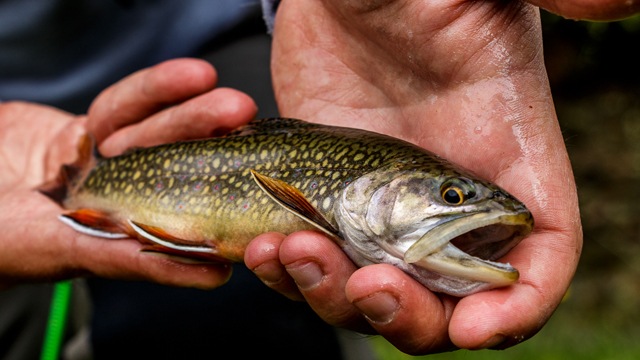
It stands to reason that, just as there is no single absolute measurement that is the “best” length for tenkara casting lines, the ideal tenkara tippet length will vary according to the situation. In fact the legend of the original tippet length measurement is a really nice example of adaptability…
Traditional Tenkara Tippet Length
It is said that the traditional way to judge the correct length for your tippet (or “Harisu”/ はりす) in Japanese) in tenkara is by reference to Kyūdō (弓道); the Japanese military archery discipline.
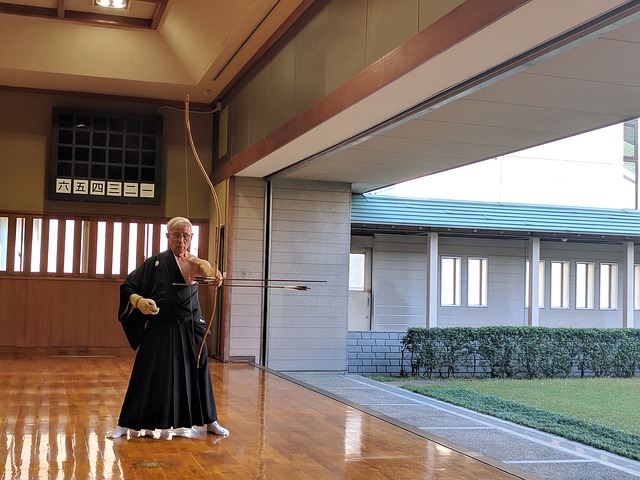
The idea is that your tippet length should match your draw-length in that style of archery (i.e. the distance from where you hold the bow in your left hand, stretched back to the full-draw point). The important detail is that, unlike western archery, in Kyudo you draw the arrow all the way back behind your right ear – like this:
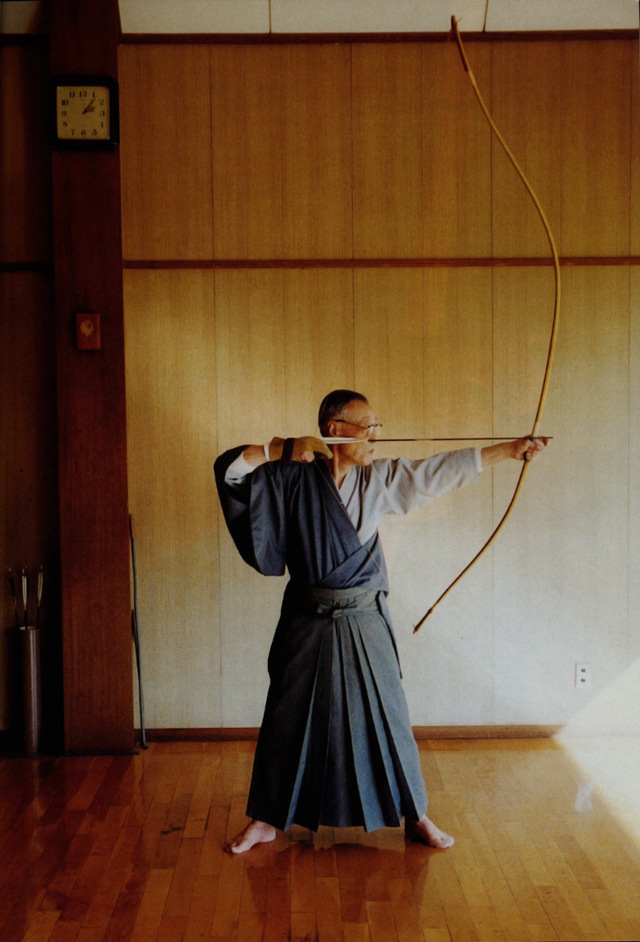
That distance is, typically, about half of your height.
Here’s the clever/adaptable part of using that approach as a reasonable starting point…Every angler is different in terms of height and arm-span etc. The great thing is, if you are a little bit taller, you can afford to have a little bit extra length of tippet and you will still be able to easily hold all the casting line off the water…and vice versa. Because your arm span broadly varies in some proportion to your height, that change in draw-length should broadly track the differences in height (and hence the ability to hold line off the water).
Tactical Reasons to Vary Tippet
While the above measurement is actually a pretty damn good system to start out with, what might be some of the reasons to stray from that rule of thumb?
There are five main ones that I can easily think of:
- Casting Accuracy
- Fly Control
- Stealth (in vertical plane)
- Stealth (in horizontal plane)
- Reach
Let’s look at each of these in turn…
Tenkara Tippet Length for Casting Accuracy
Basically, along with slightly stiffer fluorocarbon material and the use of a single fly-rig (without droppers), the shorter your tippet, the more accurate you can be with precisely where you deliver your kebari (fly).
Particularly for anchoring flies in very small current eddies and features – or simply hitting a fish-holding spot the same diameter as a tin of beans – you will want your tippet as short as you can get away with. You’ll also want your fly to have a fairly small and symmetrical hackle so that it travels through the air predictably and doesn’t kick off to one side or the other.
In remote rivers and streams in Japan, where you need to walk a day or more to reach the fishing grounds, it isn’t unusual to see tippets of around 45 cm (18 inches). That allows you to be extremely accurate while the fish are often a little bolder compared to waters with higher angler traffic. To further aid accuracy, these are usually made of slightly wiry fluorocarbon in the #1 to #1.2 diameter range (on the Japanese line-diameter scale: See the “Japanese line-rating number versus diameter” table on this page).
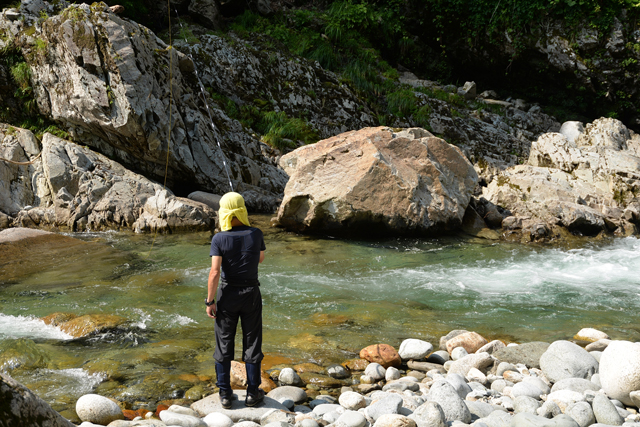
In some cases though, tippet as short as that can lead to spooking of fish – particularly with brighter casting line colours on bright/high-contrast days.
Increased Fly Control via Shorter Tippet
In a similar way to pin-point accuracy in casting, the waves that you transmit along the rod and down your casting line can be more faithfully passed down to your kebari (fly) with a shorter tippet.
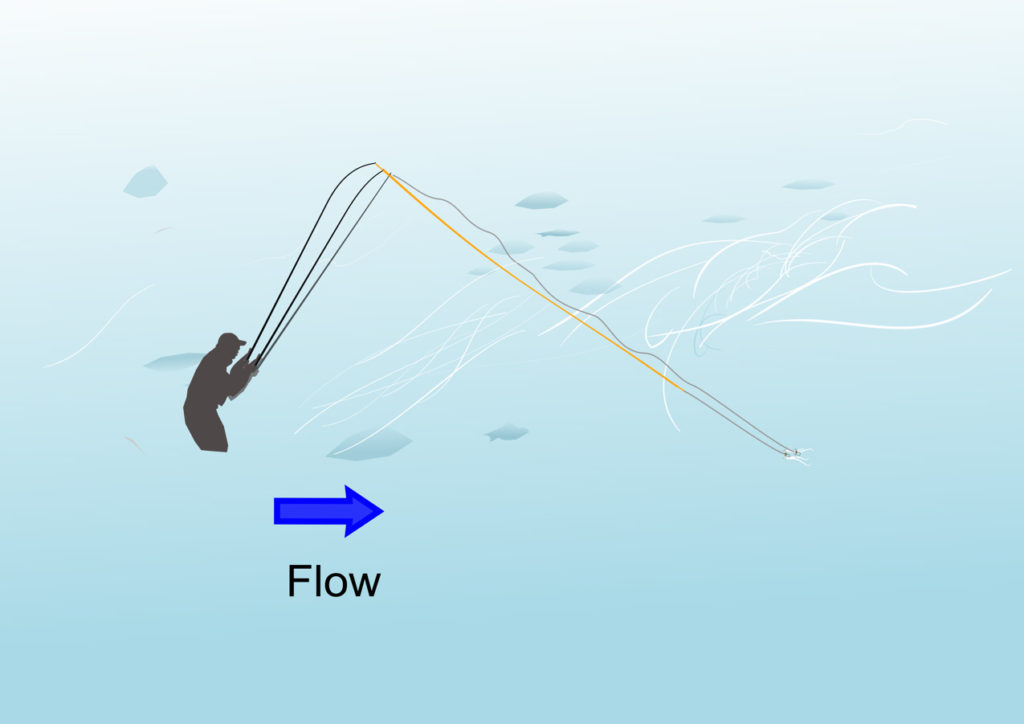
When that tippet length is significantly reduced, there is much less of a hinging effect between the tip of the casting line and the connection to the fly. Additionally, if there is a slight wiry texture to the tippet, the springy “coils” that are fed down the line between each pulse seem to also be transmitted better. On the flip side, a softer tippet material almost certainly allows a more natural mobility during various drifted presentations that rely less on active pulsation from the rod-tip.
Tenkara Tippet Length & “Vertical” Stealth
This is basically a case of making your tippet longer than the traditional “archery draw” length in order to be able to hold the potentially distracting/spooking coloured casting line much higher off the water. This creates a greater separation between the fly (which you want the fish to see/focus on) and the line (which you definitely do not want the fish to focus on).
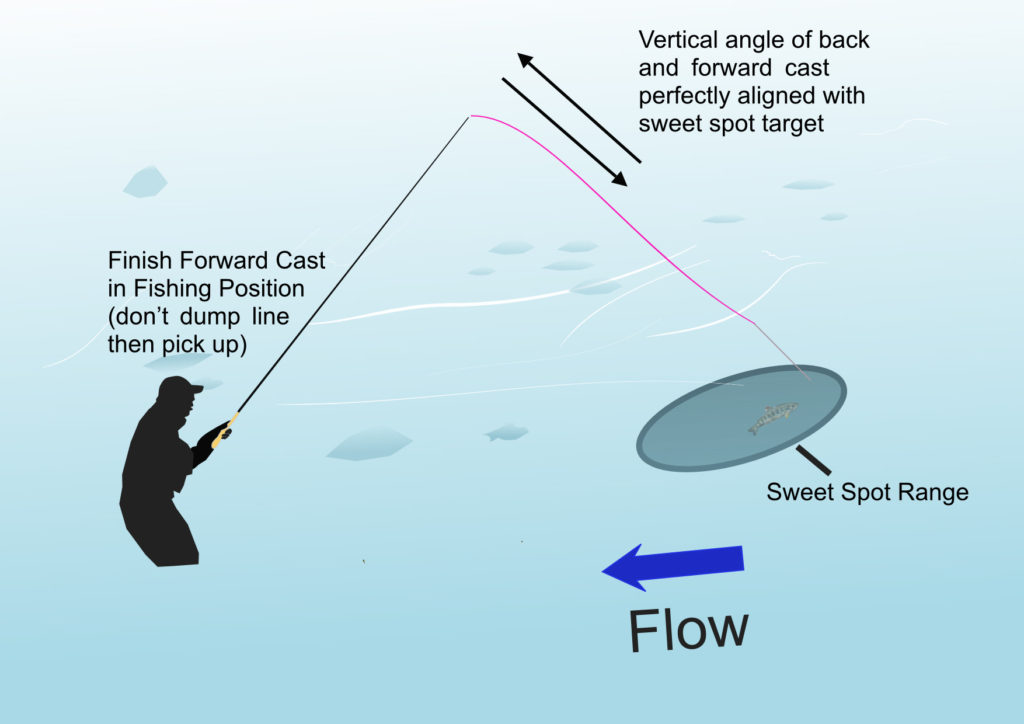
Depending on the breeze, your stance on/above the river, the length of your rod and how heavy your casting line is; you might be able to easily add quite a bit more length to the tippet. Sometimes, though, it may mean that you need to hold the rod tip a little higher – which could potentially become uncomfortable over longer durations. The maximum tippet length for this tactic would probably be just under 2-metres – and more often somewhere in the 1.2 to 1.5-m ballpark.
It is also obvious that your pinpoint accuracy is likely to be reduced – so there is always a trade off as to which is most important on any particular day.
“Horizontal” Stealth
In this case I’m referring to the situations where you cannot help laying line on the water. This could be due to low tree canopy cover that limits your ability to hold the rod vertical. Alternatively, it could be the longer range “Honryu” style of tactics described in this article on tenkara level line length which unavoidably leads to more casting line laying on the water. Either way, there is a greater need to separate the “splashdown” of the casting line from that of the kebari (fly) – even if that line splashdown happens after the fly hits the water.
Having the fly land first should be the case in almost all tenkara casts – even when fishing long-line Honryu tactics. It is even (deliberately) the case in many casts described under the FFM Italian casting approaches
Of course, a longer casting line (whether tenkara or “western” fly fishing) has to land on the water sometime (once the line gets longer than the rod can hold off the water). Whether the casting line lands before the fly or vice versa, there is a significant factor that is common to long-line tenkara and a “western” fly line landing. That common factor is the need to create significant separation between the point where the casting line lands on the water and where the fly lands.
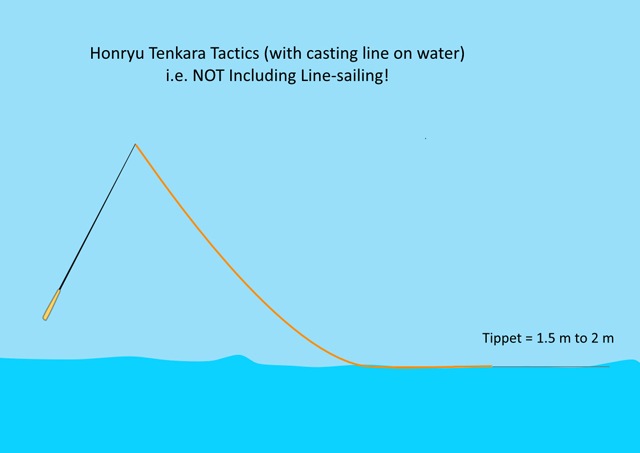
In honryu fishing with long level lines or with long nylon tapered lines on high angler-traffic waters, a tippet of a minimum of 1.5 m and often up to 2 m is necessary to create that horizontal separation between casting line and kebari. This is also true of sunk-fly tactics where the tip of the level line is also deliberately sunk below the surface. Great examples of this are the Masami Sakakibara honryu tactics and rigs with large unweighted kebari as well as the Kazumi Saigo example tactics/rigs with tungsten bead-head kebari featured in the tenkara level line length article linked above.
Increased Reach via Longer Tippet
Coming back to our old friend “Drape Otsuri” again, it can be possible (as long as you’re not fishing directly into a head-wind) to offset the tendency for casting line to hang down vertically from the tip of your rod. One of the quickest ways to do this is by extending the fine tippet length – since this immediately creates a much lighter section at the tip of the rig.
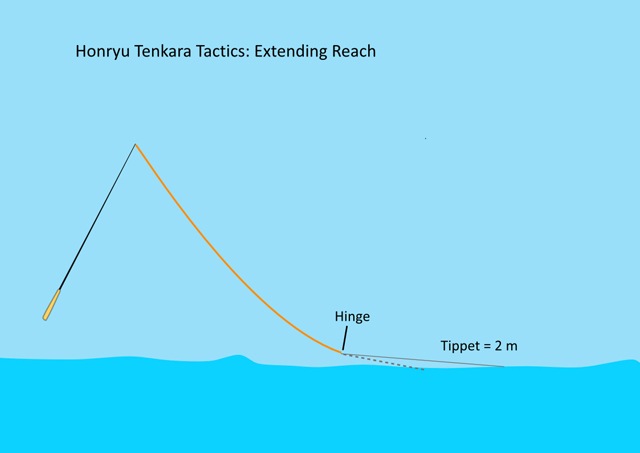
Even if the line is hanging pretty straight down, it is possible to have that tippet extend almost parallel to the water – especially if you are able to use a stiff-hackled wet fly to lock into a particular current flow.
Quick Hack for Setting Tenkara Tippet Length
Here’s a reward for reading all the way down (or perhaps searching this out first!). Once you’ve decided on your ideal tippet length for your tenkara session, you’ll want to set that length as accurately as possible. John (Pearson) often teaches clients a foolproof way of doing this – along with some other really nice shortcuts for creating instant measurements (but we’ll go into that elsewhere!).
Anyway, the trick is this: always pull off enough tippet to form your connection knot (plus a little spare) from the spool. Then tie your knot to attach the tippet to the end of your casting line BEFORE you snip the tippet off from the spool. If it helps, you can hold the spool (with tippet still attached) either in your front pocket or in a small on-stream pack while you form that knot.
Then, pull off more of the tippet from the spool and make a very accurate measurement of the exact length that you require (leaving enough spare to attach your fly of course). Then snip off that length and attach your kebari. This way, you get exactly the length of tippet you want AND you significantly reduce the amount of tippet waste (because normally, if you cut off a length before tying it on, you’ll always err on the generous side!).
Tenkara Tippet Length: Take Home Messages
- If in doubt, start off with an archer’s draw length of tippet (typically this would be about half of an archer’s height) and aim to hold almost all of that off the water by combining it with a suitable length of tenkara casting line – matched to the length of rod you are using.
- You can reduce the tippet length to less than this basic guideline if you need extra accuracy and/or extra control of your fly “manipulations” (sasoi)
- You can extend the tippet length if you need to increase stealth by holding the tip of the casting line higher off the water, by increasing the lateral separation of the splashdown of casting line vs. kebari or by increasing the separation between the sunken portion of the casting line and a sunken kebari.
- You can also extend the tippet length in order to extend your fishing range by reducing “Drape Otsuri”
- EXTENDING THE TIPPET WILL ALWAYS REDUCE YOUR ACCURACY
Paul
PS – Found this guidance useful? Why not spread the love by sharing this article (people will say great things of you in times to come 🙂

Paul, as expected, this post and the previous post about choice of level line length are informative, useful and interesting things to ponder. Maybe I ought to adjust my current practice.
Most often I see this Japanese term used. Yabiki, 矢引 (or 矢引き) [= arrow + pull].
A yabiki being half the length of 1ヒロ (1 hiro ), [1ヒロ とは?, what is one hiro?]. An arm span. One fathom being the English term for the same idea of a length measurement based on an out stretched arm span.
However, the Japanese use another term for water depth. Tana [タナ とは?]. For example the tana タナ might be 2 hiro 2ヒロ.
Yabiki and hiro are nicely shown in this drawing:
http://www.hetaturi.com/archives/image2013/large/pages/20130521_01.html